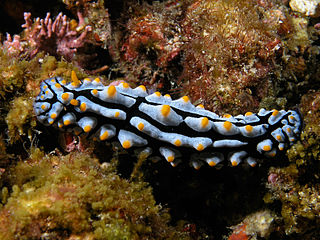
Nembrotha lineolata is a species of nudibranch, a sea slug, a marine gastropod mollusk in the family Polyceridae. It is found in shallow water in the Indo-Pacific. It was first described in 1905 by the Danish malacologist Rudolph Bergh. The type locality is Selayar Island, Indonesia.

Phyllidia babai is a species of sea slug, a dorid nudibranch, a shell-less marine gastropod mollusk in the family Phyllidiidae.

Phyllidia varicosa is a species of sea slug, a dorid nudibranch, a shell-less marine gastropod mollusc in the family Phyllidiidae.
Asteronotus is a genus of sea slugs, dorid nudibranchs, shell-less marine gastropod molluscs in the family Discodorididae.

Phyllidiopsis fissurata is a species of sea slug, specifically a dorid nudibranch, a shell-less marine gastropod mollusk in the family Phyllidiidae.

Goniobranchus lekker is a species of colourful sea slug, a dorid nudibranch, a marine gastropod mollusc in the family Chromodorididae.

Chromodoris lineolata is a species of colourful sea slug, a dorid nudibranch, a marine gastropod mollusc in the family Chromodorididae.

Hypselodoris nigrostriata is a species of sea slug or dorid nudibranch, a marine gastropod mollusk in the family Chromodorididae.
Hypselodoris alboterminata is a species of sea slug or dorid nudibranch, a marine gastropod mollusk in the family Chromodorididae.

Hypselodoris maritima is a species of colourful sea slug or dorid nudibranch, a marine gastropod mollusk in the family Chromodorididae.

Miamira sinuata is a species of colorful dorid nudibranch, a sea slug, a shell-less marine gastropod mollusk in the family Chromodorididae. This species is found in the Indo-Pacific.
Asteronotus mimeticus is a species of sea slug or dorid nudibranch, a marine gastropod mollusk in the family Discodorididae.

Phyllidia coelestis is a species of sea slug, a sacoglossan, a shell-less marine gastropod mollusc in the family Phyllidiidae.

Phyllidiella annulata is a species of sea slug, a dorid nudibranch, a shell-less marine gastropod mollusk in the family Phyllidiidae.

Phyllidiella nigra is a species of sea slug, a dorid nudibranch, a shell-less marine gastropod mollusk in the family Phyllidiidae.
Dermatobranchus gonatophorus is a species of sea slug, a nudibranch, a marine gastropod mollusc in the family Arminidae.
Dermatobranchus pustulosus is a species of sea slug, a nudibranch, a marine gastropod mollusc in the family Arminidae.

Dermatobranchus striatus is a species of sea slug, a nudibranch, a marine gastropod mollusc in the family Arminidae.

Asteronotus hepaticus is a species of sea slug or dorid nudibranch, a marine gastropod mollusk in the family Discodorididae.

Phyllidiella rosans is a species of sea slug, a dorid nudibranch, a shell-less marine gastropod mollusk in the family Phyllidiidae.















